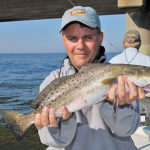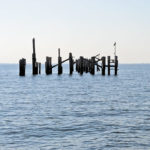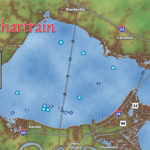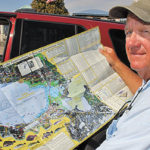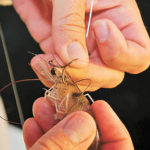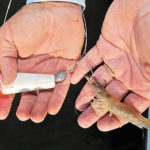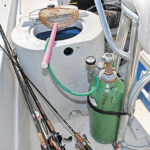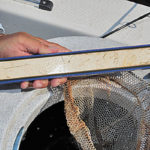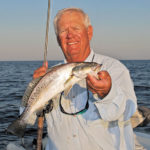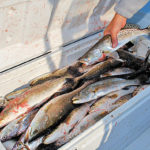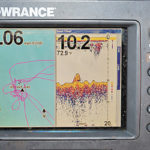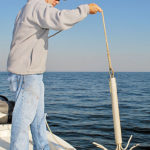
Lake Pontchartrain is entirely devoid of fish attracting structure. Or is it?
Silver-haired and tanned, Dr. Bob Weiss spoke with an authoritative air, like he was used to being obeyed.
“Lake Pontchartrain is hard to fish, and with the removal of a lot of the wells out here, it has gotten harder,” he said. “I would recommend to anyone who wants to fish in the lake that they use the (Lake Pontchartrain Fishing and Recreation Guide) put out by the Lake Pontchartrain Basin Foundation. It’s a one-stop shop for the area, a wonderful little tool.”
A self-described “fishing addict,” the retired Slidell physician fishes 200 to 250 days a year for speckled trout in the waters between Lake Pontchartrain and Venice.
“It’s just the phase I’m in now,” he said. “I think that everyone goes through phases.”
He started fishing at 12 years of age in the New Orleans City Park lagoons and Bayou St. John for bass, or as they were called then, “green trout.” He fished in bass clubs avidly until about 1990, when he became “obsessed” with peacock bass in the Amazon. That lasted 10 years. He gave it up after being kidnapped and having caught so many that the edge was gone.
His fishing partner on the lake for the day was one of his usuals, Ricky Trahant, a Metairie attorney his junior by over two decades.
“I have been fishing with Bob a lot since Katrina, but I also fished with him some before,” he said. “Like every kid that lives around here, I fished Delacroix and Empire. After law school, I got back into Delacroix, but I heard about all the big trout that Dudley Vandenborre was catching. So I chartered a trip with him, and it boggled my mind.
“We caught 65 trout, and exactly 40 of them were over 4 pounds. I Boga-Gripped every one of them. In Delacroix, I was catching 3-pounders and calling them 5,” he said with a sheepish grin. “In the lake, I started really catching 5-pounders.
“But I learned that Lake Pontchartrain is the most complex ecosystem anywhere — it doesn’t have structure; it doesn’t have marsh. Fish don’t school like elsewhere, aside from the bridges. It’s a very complicated place to fish. I learned everything I know from Dudley and Chink [Sumas] and him,” he said while pointing his rod tip at Weiss.
First stop in the morning was one of the three artificial reefs located west of the Causeway Bridge and off of the Jefferson Parish shoreline. Located in 13 feet of water, the shell pad and concrete reef balls rose 3 feet off the surrounding bottom.
Weiss scrutinized his depth-sounder screen while he positioned the boat.
“It’s kind of critical how the boat is positioned,” he said. “I like to get on top of the reef and fish the edges with short casts.”
While Trahant lowered and set the Mighty Mite Reef Anchor, Weiss explained that concrete reef balls eat Danforth anchors and never regurgitate them.
The day’s tide range of 0.1 feet was anemic, but Weiss brought live shrimp, hoping that they would overcome any reluctance to feed on the part of the fish. Still, both men started with artificial lures.
“I like to try to fish plastic,” explained Weiss. “If they take plastic, we can avoid the dreaded live bait.”
Weiss rigged a Deadly Dudley opening night Bay Chovey on a tight-line, while Trahant tied on a sinking MirrOlure. But the fish weren’t having anything of eating hardware, so first Weiss and then Trahant rigged for fishing live bait.
Weiss slipped on a sliding cork set at 9 feet, while Trahant used a Carolina rig. Each used a No. 6 treble hook. The “little bitty treble hook,” said Weiss, allows a shrimp to swim naturally and it doesn’t let the trout throw the hook.
Both men immediately hooked up — Weiss to a modest-sized trout, Trahant to a reef ball. While Trahant re-rigged another Carolina rig, Weiss caught two more specks. On Trahant’s second cast, the result was the same. He caught a reef ball, and Weiss caught another trout.
Weiss was free with his advice to Trahant, as he would be all day. The good-natured Trahant took it or ignored it all day as he saw fit for the circumstances. But after breaking off the second time, he quickly followed Weiss’s lead with a sliding cork rig.
Every cast yielded fish, none over 2 pounds, but all eager and willing. It was still early, but the rising rays of the sun revealed the lake’s waters to be gin-clear. Every speck on every trout being brought in was clearly visible 3 feet down.
“Here’s a tip for best fishing in the lake,” rumbled Weiss. “Fish early in the morning; fish late in the evening and fish an hour before and an hour after the tide change. Also pay close attention to solunar tables.”
“He’s made a believer out of me with those,” chimed in Trahant. “The best time to fish and the best time to catch big fish is during a major period.”
We were just coming up on a major period, and fish were flying into the boat. It was almost boring. Although the fish were all less than 2 pounds, Weiss made no apologies.
“I am an addicted fisherman,” he said. “I’ll catch what’s there. My two largest speckled trout were both over 9 pounds, both caught on avocado Deadly Dudleys, but I will catch what’s biting.”
But finally the small fish got boring even for Weiss, so the two men made the short run to the Causeway.
“This is the opposite of fishing the reefs,” said Trahant. “It is more akin to bass fishing. There is always a pattern, although it takes a little time to figure it out. How close to the pilings are they? Which side of the piling? Do I hop the bait, drag the bait or let it sit still?”
Trahant went on with his bridge fishing primer.
“Fishing the bridge is an anytime of the day fishery,” he said. “It is 24 miles long, and fish could be anywhere along its length. If you don’t have word of mouth to tell you where fishing is best at any one time, just look for the boats.
“The most important thing about fishing the Causeway is to be sure to let the bait hit the bottom before beginning the retrieve. It is 13 to 14 feet deep along the bridge. Always start by hitting the northwest corner of each piling first. That’s the best corner.”
Weiss nodded in agreement.
First Weiss, then Trahant hooked up to hefty trout. Every few casts, they put a 2- to 4-pound fish in the ice chest.
Both men really like to fish the Causeway.
“There are fewer people than on the other bridges because they are spread out over the whole length of the bridge,” said Weiss. “At the other bridges, the Trestles, the Twin Spans and Highway 11, most of the fish are within one-half mile of the bank. Plus the Causeway has fewer snags to hang up on.”
Strong-willed and driven, Weiss decided that the specks on the bridge, while nice-sized, were too few.
“Let’s go try some rigs,” he said in the tone of a decision already made.
Trahant grinned and nodded.
The duo made three stops at “rigs,” although two were no longer rigs but simply the shell pads that remained after the well pilings had been removed. The specks were small and few, and Weiss rapidly lost interest.
It was 10:30 and their big ice chest was bulging with fish even though they were a few short of a limit.
Weiss swiveled on his front seat while he hooked his line to his reel for storage and pronounced, “Like Chink Sumas says, ‘it’s biscuit time.’”
